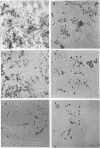Abstract
A lepidopteran toxin gene of the entomopathogen Bacillus thuringiensis subsp. kurstaki HD-1 was introduced into a cotton leaf-colonizing Bacillus megaterium strain, RS1, by conjugal transfer. Rifampin- and nalidixic acid-resistant colonies obtained after cell mating were screened for crystal production by microscopy. A transcipient, B. megaterium RS1-43, was selected by this procedure. Southern blot hybridization with both total DNA and HindIII-digested DNA of the transcipient showed positive signals with a cryIA-specific probe, suggesting the transfer of the lepidopteran-specific cryIA(a) gene. Sodium dodecyl sulfate-polyacrylamide gel electrophoresis and immunoblot analysis confirmed the presence of the 134-kDa toxic crystal protein specific to lepidopteran larvae in the transcipient. Survival studies with cultures of the transcipient at both vegetative and postvegetative growth stages on cotton, under field conditions, suggested that the bacterium persisted on the leaf surfaces for more than 28 days, with a gradual decline in the population level with time, while the donor, B. thuringiensis subsp. kurstaki, disappeared completely after 7 days following inoculation. An in situ differential crystal-staining technique indicated the production of crystals by the transcipient on cotton leaf surfaces for about 30 days. Leaf bioassays of cotton plants inoculated with a single spray of the transcipient showed 75- to 96% mortality to the first-instar larvae of Heliothis armigera up to 21 days, and this single spray conferred total protection to the plants for about 30 days by causing an antifeeding effect on the remaining larvae.
Full text
PDF








Images in this article
Selected References
These references are in PubMed. This may not be the complete list of references from this article.
- Angsuthanasombat C., Panyim S. Biosynthesis of 130-kilodalton mosquito larvicide in the cyanobacterium Agmenellum quadruplicatum PR-6. Appl Environ Microbiol. 1989 Sep;55(9):2428–2430. doi: 10.1128/aem.55.9.2428-2430.1989. [DOI] [PMC free article] [PubMed] [Google Scholar]
- Battisti L., Green B. D., Thorne C. B. Mating system for transfer of plasmids among Bacillus anthracis, Bacillus cereus, and Bacillus thuringiensis. J Bacteriol. 1985 May;162(2):543–550. doi: 10.1128/jb.162.2.543-550.1985. [DOI] [PMC free article] [PubMed] [Google Scholar]
- Birnboim H. C., Doly J. A rapid alkaline extraction procedure for screening recombinant plasmid DNA. Nucleic Acids Res. 1979 Nov 24;7(6):1513–1523. doi: 10.1093/nar/7.6.1513. [DOI] [PMC free article] [PubMed] [Google Scholar]
- Bunster L., Fokkema N. J., Schippers B. Effect of Surface-Active Pseudomonas spp. on Leaf Wettability. Appl Environ Microbiol. 1989 Jun;55(6):1340–1345. doi: 10.1128/aem.55.6.1340-1345.1989. [DOI] [PMC free article] [PubMed] [Google Scholar]
- Goldburg R. J., Tjaden G. Are B.T.K. plants really safe to eat? Biotechnology (N Y) 1990 Nov;8(11):1011–1015. doi: 10.1038/nbt1190-1011. [DOI] [PubMed] [Google Scholar]
- González J. M., Jr, Brown B. J., Carlton B. C. Transfer of Bacillus thuringiensis plasmids coding for delta-endotoxin among strains of B. thuringiensis and B. cereus. Proc Natl Acad Sci U S A. 1982 Nov;79(22):6951–6955. doi: 10.1073/pnas.79.22.6951. [DOI] [PMC free article] [PubMed] [Google Scholar]
- González J. M., Jr, Dulmage H. T., Carlton B. C. Correlation between specific plasmids and delta-endotoxin production in Bacillus thuringiensis. Plasmid. 1981 May;5(3):352–365. doi: 10.1016/0147-619x(81)90010-x. [DOI] [PubMed] [Google Scholar]
- Höfte H., Whiteley H. R. Insecticidal crystal proteins of Bacillus thuringiensis. Microbiol Rev. 1989 Jun;53(2):242–255. doi: 10.1128/mr.53.2.242-255.1989. [DOI] [PMC free article] [PubMed] [Google Scholar]
- Kronstad J. W., Whiteley H. R. Three classes of homologous Bacillus thuringiensis crystal-protein genes. Gene. 1986;43(1-2):29–40. doi: 10.1016/0378-1119(86)90005-3. [DOI] [PubMed] [Google Scholar]
- LOWRY O. H., ROSEBROUGH N. J., FARR A. L., RANDALL R. J. Protein measurement with the Folin phenol reagent. J Biol Chem. 1951 Nov;193(1):265–275. [PubMed] [Google Scholar]
- Laemmli U. K. Cleavage of structural proteins during the assembly of the head of bacteriophage T4. Nature. 1970 Aug 15;227(5259):680–685. doi: 10.1038/227680a0. [DOI] [PubMed] [Google Scholar]
- McGuire M. R., Shasha B. S. Sprayable self-encapsulating starch formulations for Bacillus thuringiensis. J Econ Entomol. 1990 Oct;83(5):1813–1817. doi: 10.1093/jee/83.5.1813. [DOI] [PubMed] [Google Scholar]
- Murphy R. C., Stevens S. E., Jr Cloning and expression of the cryIVD gene of Bacillus thuringiensis subsp. israelensis in the cyanobacterium Agmenellum quadruplicatum PR-6 and its resulting larvicidal activity. Appl Environ Microbiol. 1992 May;58(5):1650–1655. doi: 10.1128/aem.58.5.1650-1655.1992. [DOI] [PMC free article] [PubMed] [Google Scholar]
- Murty M. G. Phyllosphere of cotton as a habitat for diazotrophic microorganisms. Appl Environ Microbiol. 1984 Oct;48(4):713–718. doi: 10.1128/aem.48.4.713-718.1984. [DOI] [PMC free article] [PubMed] [Google Scholar]
- Obukowicz M. G., Perlak F. J., Kusano-Kretzmer K., Mayer E. J., Watrud L. S. Integration of the delta-endotoxin gene of Bacillus thuringiensis into the chromosome of root-colonizing strains of pseudomonads using Tn5. Gene. 1986;45(3):327–331. doi: 10.1016/0378-1119(86)90031-4. [DOI] [PubMed] [Google Scholar]
- Perlak F. J., Deaton R. W., Armstrong T. A., Fuchs R. L., Sims S. R., Greenplate J. T., Fischhoff D. A. Insect resistant cotton plants. Biotechnology (N Y) 1990 Oct;8(10):939–943. doi: 10.1038/nbt1090-939. [DOI] [PubMed] [Google Scholar]
- Schnepf H. E., Whiteley H. R. Cloning and expression of the Bacillus thuringiensis crystal protein gene in Escherichia coli. Proc Natl Acad Sci U S A. 1981 May;78(5):2893–2897. doi: 10.1073/pnas.78.5.2893. [DOI] [PMC free article] [PubMed] [Google Scholar]
- Spizizen J. TRANSFORMATION OF BIOCHEMICALLY DEFICIENT STRAINS OF BACILLUS SUBTILIS BY DEOXYRIBONUCLEATE. Proc Natl Acad Sci U S A. 1958 Oct 15;44(10):1072–1078. doi: 10.1073/pnas.44.10.1072. [DOI] [PMC free article] [PubMed] [Google Scholar]
- Towbin H., Staehelin T., Gordon J. Electrophoretic transfer of proteins from polyacrylamide gels to nitrocellulose sheets: procedure and some applications. Proc Natl Acad Sci U S A. 1979 Sep;76(9):4350–4354. doi: 10.1073/pnas.76.9.4350. [DOI] [PMC free article] [PubMed] [Google Scholar]





